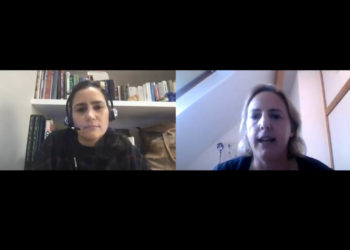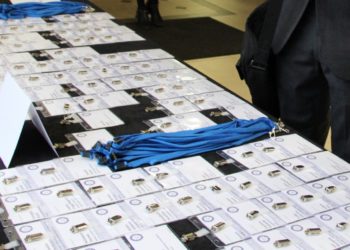Since the start of the COVID-19 pandemic, the way we interact with one another has changed dramatically for most of us in the scholarly publishing community. Working in the office has been replaced by working from home, and physical conference attendance has been replaced by online events. Earlier this month, Mark Carden, Director of Researcher to Reader, wrote about the costs associated with conferences. Following on from our conversation about Neurodiversity in December, Publishing Enabled hosted a discussion between two publishing professionals and two conference providers about how to make conferences – both in-person and online – more accessible to people with disabilities. The conversation aimed to set out the major challenges faced by conference attendees with disabilities, propose some solutions, and look towards what more inclusive conferences could look like in the future. A recording and a summary of our discussion are available below.
Chairs:
- Ruth Wells (Founder and Innovator, Inventing Change)
- Katy Alexander (Global Director of Marketing, Digital Science)
Participants:
- Simon Holt (Book Publisher at Elsevier, who is visually impaired)
- Erin Osborne-Martin (Senior Society Partnership Manager and Analytics Manager at Wiley, who has a spinal cord injury and is ambuplegic – an incomplete paraplegic who uses mobility aids)
- Mark Carden (Director, Researcher 2 Reader)
- Violaine Iglesias (CEO and Co-Founder of Cadmore Media, who have hosted several online publishing industry events, including this week’s NISO Plus 2021)
You can watch our video below:
Here is a summary of what we discussed:
The Major Challenges: What Is the Current Situation?
The accessibility of in-person conferences depends very much on both the venue and the conference organizer. While disability discrimination legislation exists in several countries, the reality is that the picture is mixed. Some conference organizers make a big effort to make life as easy as possible for people with disabilities; other conferences are harder to access, both in terms of the organizers and the physical locations.
The situation is slightly rosier for online conferences. As Violaine explains, there is already a baseline to build on:
The first thing is to apply the rules of web accessibility to online conference platforms and make sure that they are compatible with screen readers, that they can be navigated with a keyboard, that the color contrasts are right for videos. We need to make sure that there are captions, but there is already a set of rules that you can start from … And that’s what the platform should provide, really. That’s the venue being accessible.
Whilst there may be hybrid conferences in the future, at the moment the reality is that in-person conferences and digital, online conferences are separate entities. Prior to the past 12 months, the vast majority of scholarly communications were in-person; since then, this has quickly pivoted to online. We therefore discussed both in-person and online conferences, recognizing that there are overlaps both in terms of challenges and solutions, while also understanding that they are fundamentally separate entities. As Violaine said, “There is not going to be wine at an online conference. It’s always going to be sad, but that’s just a fact of life. So, let’s focus on the things that you can do.” The opportunities that online conferences offer are different to those available at in-person ones, so we treat them separately here.
We identified the major challenges for attendees with disabilities, based on our experiences, as follows:
In-Person Conferences
- Logistics: How easy is the airport to navigate? Is it easy to get from the airport to the hotel / conference venue? On arrival, is the hotel / conference venue accessible to wheelchair users? How easy is it to navigate around the conference area / find the talks?
- Networking: Does the networking space have somewhere to sit down for those who need it? What are the alternatives if you can’t read other attendees’ name badges?
- Conference Sessions: What are the options for attendees who are unable to see the slides or hear the talk?
Online Conferences
- Attendee Names: It is often difficult to work out who else is in the audience, as attendee names are often listed in the corner of the screen and require a lot of scrolling to move through them.
- Chat Functionality: The chat box is a relatively crude way of interacting for everyone, whether you have a disability or not. The pace of the chat often moves very quickly, which is hard to keep track of (particularly if you’re visually impaired). In many cases, different types of content – comments, questions, tech issues, links – are all crammed in together, making it difficult to follow, particularly if you’re trying to listen to the presenter at the same time. This is completely impossible if you are using a screen reader, as you can’t listen to that and the presenter at the same time. Online chats can also be biased towards extroverts, as they can often be dominated by a few contributors, which leaves little room for others – particularly quieter individuals – to be heard.
There may be additional challenges for speakers and moderators, such as sharing slides, hearing loops in rooms, or being able to see when someone is asking you a question, either in a conference room or in the chat.
The Way Ahead – Proposing Some Solutions
We agreed that there is no ‘magic bullet’ that will solve accessibility for everybody, as each individual has different needs. Nor is it about fundamentally changing the way we do business, either in person or online. As Mark commented, accessibility is about, “lots of incremental, small things which make a big difference. It’s not about pulling your building down and starting again.” Violaine pointed out that it’s not about finding one solution that is going to suit everyone, but, rather, providing multiple solutions – for example, text chat *and* audio chat online – that meet individuals where they are.
Advance planning, by both conference organizers and attendees, is essential to make sure that individuals requiring adjustments are able to enjoy the conference in the same way as everybody else – whether that’s in person or online. This is important, not only so that attendees know they are getting the help they need, but also so that conference organizers understand the needs of the people attending and are able to plan accordingly. It means that things are less likely to go wrong on the day, and all attendees are better able to enjoy and engage with the conference.
Our priority recommendations applying to both in-person and online conferences, are the following:
- Special Requirements: Conference organizers should ask attendees if they have a disability and require any special adjustments at registration. As Violaine points out, “If you’re going to be asking people what they need for lunch, you can certainly ask them if they need any special help.”
- Conference Contact: Conference organizers should also include contact information on the conference website for anyone requiring assistance or adjustments. This allows attendees to contact the organizers ahead of time to make sure their needs can be met. For in-person conferences, Simon spoke about arranging a tour of the venue the day before the conference, to be able to navigate the space before crowds arrive. For online conferences, conference organizers could make materials such as slides available to individuals in advance where possible, so users can access these with screen readers, for example.
Other suggestions include:
In-Person
- Attendee Lists: Make attendee lists available (minus contact details, for GDPR compliance) before the conference, so attendees are able to arrange who, when, how, and where to meet with others. This decreases the reliance on ‘bumping into people’, which can be challenging if you have a sensory or mobility impairment.
- Conference Facility Map: Publish the conference map on the website for in-person conferences. Identify clear, well-signposted meeting places to aid meeting. It would be great if these maps were interactive and included voice commands, so attendees could be guided around the venue using the conference map and voice commands (as in Google Maps).
Online Conferences
- Advance Recording: Speakers should record their sessions in advance where possible. This allows accurate closed captions to be generated, increasing the accessibility of the sessions. This would also allow individuals who need to access materials using a screen reader to receive them in advance, enabling them to take a fuller part in the discussion.
- Online Networking: We discussed the possibility of improving the functionality for online chat and for networking in general. This would benefit not just people with disabilities, but everybody. Ideas included having parallel small groups / breakouts in addition to the ‘main chat’ to allow more people to engage in a smaller group setting. In addition, offer a ‘networking bus stop’ to allow those who want to meet new people to have a way of appearing available and willing to talk.
In addition…
- Personality Types: At any conference there is always a mix of extroverts and introverts and it is important to cater for both. We suggest having a ‘quiet room’ at an in-person conference for those needing a break from the action, or a ‘virtual lobby’ at online conferences for those who relish the social side of things, and wish to connect with more people, beyond what is available in the structured sessions. Violaine also spoke of potential increased personalization through online conference profiles, to ‘match’ those attendees with similar interests in a networking context.
Looking Ahead: The Future of Conferences Beyond Covid-19
Violaine comments that, ‘people go to conferences to access content and people, so both these aspects need to be accessible.’ Innovations that improve the accessibility of conferences for people with disabilities improve the experience for everybody, because they make it easier to interact with both the content and the people.
We agreed that the future would involve some combination of in-person and online. What that will look like exactly is uncertain. There will likely be several different online environments that come to the fore, including possible AI-based networking for people with similar interests — perhaps even a virtual avatar-led environment, where you have your own character and can circulate around the conference! It would be great for people with mobility challenges, but perhaps less appropriate for those who are visually impaired?
Erin suggested a hybrid approach, including one or two days of in-person content together with some online alternatives This would make the in-person element less tiring and also expand the variety of people who can participate, while retaining the in-person element. Mark cited the need to make sure we organize our conferences in a way that ensures inclusivity. However, we might want to ensure different user experiences for extroverts/able-bodied people/those without caring responsibilities attending in person, as opposed to introverts/those with disabilities/those with caring responsibilities accessing the conference online. It is likely impossible to make an in-person or online conference 100% accessible for everybody. But, by working with individuals to resolve the major pain points, we can help our industry ensure that a conference is as viable and enjoyable as possible for everybody who attends.
You can access our full conversation below:
Discussion
2 Thoughts on "Guest Post — Towards Accessible Conferences: A Conversation"
Excellent, thank you all, very insightful and educational
What a great guest post. As a conference organiser, this was very, very useful.



